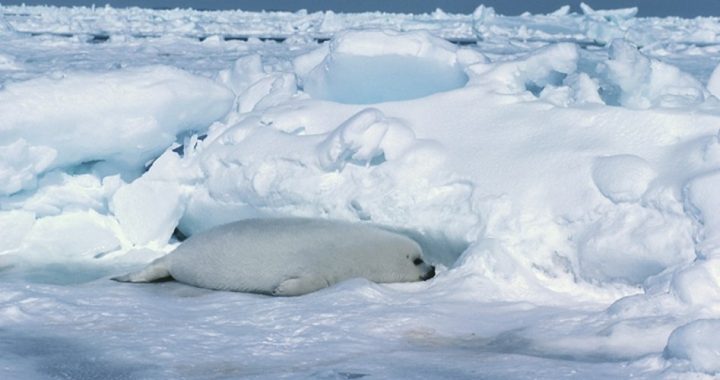
A NASA study released on May 14 claims that the Larsen B Ice Shelf in Antarctica is weakening quickly and will likely disintegrate completely in the next few years, contributing to rising sea levels. However, other NASA data released in May dispels this gloomy forecast, and shows show polar sea ice is approximately five percent above the post-1979 average. It was in 1979 that satellite instruments began measuring the ice caps, so figures from that year serve as a base line.
Part of the Larsen B Ice Shelf, which scientists estimate to be about 10,000 years old, collapsed in 2002.
A report from Reuters quoted Eric Rignot, identified as a co-author of the new study and a glaciologist at NASA’s Jet Propulsion Laboratory in Pasadena, California, who said: “This study of the Antarctic Peninsula glaciers provides insights about how ice shelves farther south, which hold much more land ice, will react to a warming climate.”
Rignot did not specify whether he believes that any warming of the climate might be due to natural, cyclic patterns, or if he is among those who assert that “global warming” is anthropogenic — or caused by man.
The latter group is prone to making dire, almost apocalyptic predictions. As one example, the Reuters report about the study that Rignot co-authored stated:
Almost 200 countries have agreed to negotiate a United Nations pact by the end of 2015 to combat global climate change, which most scientists expect will bring about more flooding, droughts, heat waves, and higher seas.
The U.N. Intergovernmental Panel on Climate Change has cited a probability of at least 95 percent that accelerated warming of the planet has been triggered by human activities, led by atmospheric emissions of greenhouse gases from the burning of fossil fuels.
Such impending catastrophic events — flooding, droughts, heat waves, and higher seas — all allegedly caused by “emissions of greenhouse gases from the burning of fossil fuels,” have been used by the global-warming theorists working with federal agencies and the UN to impose draconian environmental regulations geared to bring the world’s industrial-based economy to its knees.
Which would be bad enough if such natural disasters were credible and the result of human activity. But a wealth of evidence exists to prove that they are not.
Just five days after Reuters reported on the study predicting the collapse of the Antarctic ice shelf, Forbes ran an article noting that NASA data released this month indicates that the situation at the polar ice caps have actually been improving. Forbes reported that the “updated data contradict one of the most frequently asserted global warming claims — that global warming is causing the polar ice caps to recede.”
The report noted a phenomenon that most scientists not caught up in the global-warming stampede admit: The Earth’s climate is subject to natural, cyclical patterns. The Earth’s average temperatures periodically cool and warm, which is why history records ice ages during certain periods, when glaciers have advanced far from the poles, and warming periods, when the glaciers have receded. Likewise, the polar ice caps periodically grow and shrink.
It so happens that 1979, when NASA first used satellite instruments to measure the polar ice caps, marked the end of a 30-year cooling trend. As a result, notes Forbes, it is likely that the polar ice caps were more extensive then than they had been for half a century. So when NASA scientists started measuring the ice caps in 1979, they were establishing a “normal” baseline that was anything but normal. (In popular terminology, large ice caps were the new small ice caps.)
The ice caps starting shrinking after 1979, and by 2012, were about 10 percent smaller than in 1979. However, notes Forbes:
A 10-percent decline in polar sea ice is not very remarkable, especially considering the 1979 baseline was abnormally high anyway. Regardless, global warming activists and a compliant news media frequently and vociferously claimed the modest polar ice cap retreat was a sign of impending catastrophe. Al Gore even predicted the Arctic ice cap could completely disappear by 2014.
Fortunately, Gore has been wrong before and was wrong about this claim. The newly released NASA data show polar sea ice is approximately five percent above the post-1979 average.
The debate about global warming goes far beyond the amount of polar ice, however. As we noted above, the doomsayers have predicted all manner of natural disasters, including flooding, droughts, heat waves, and higher seas.
And while the voices insisting that global warming is one of mankind’s gravest problems have received most of the mainstream media’s attention, quieter voices have silently gone about proving just the opposite:
• The United Kingdom’s National Weather Service, known as the Met Office, released a report in October 2012 acknowledging that “global warming” had actually stopped more than 15 years earlier, that is, since early 1997.
• Dr. J. Scott Armstrong, professor at the University of Pennsylvania, a noted world expert on forecasting, wrote: “No one has provided evidence to refute our claim that there are no scientific forecasts to support global warming.”
• Dr. S. Fred Singer, an atmospheric physicist who is the author of Hot Talk, Cold Science: Global Warming’s Unfinished Debate, when asked about his position on gobal warming in an interview with The New American’s publisher, John F. McManus, in 2000, replied, in part:
The climate warms and cools naturally all the time. It changes from day to day, month to month, season to season, year to year, and so on. At times, there is global warming; at other times there is global cooling….
Data from earth satellites in use since 1979 do not show any warming. But, eventually, they probably will because carbon dioxide and other greenhouse gases are increasing in the atmosphere. My personal guess, and I stress that this is only my guess, is that there is a greenhouse effect and that it is very small in comparison to natural fluctuations of the climate. We don’t see this effect yet, but we may notice it in the next century. Even if we do notice it, it will be extremely small and actually inconsequential. It will be an interesting scientific curiosity but it won’t be of any practical importance.
And, relevant to the recent report about the Antarctic ice shelf, Singer had something to say about that, as well:
The melting has been going on for thousands of years and the West Antarctic ice sheet is still melting. The ice sheet may even disappear in 7,000 years. But the real point is that there’s nothing we can do about it. The reason it’s melting is because it’s warmer now than when the ice formed a long time ago.
Related articles:
Computer Models vs. Climate Reality
Confab of Climate Experts to Challenge Global Warming “Consensus”
Whatever Happened to Global Warming?
“Not Evil Just Wrong”: Dissecting Environmental Extremism
Climate Change: Global Warming May be Beneficial
Scientists Debunk Climate Models
Environmentalists Lose More Credibility With Global-warming Claims
Documentary Outguns the Opposition in the Global-warming War
Greenpeace Founding Member: Climate Alarmism “Preposterous,” CO2 Emissions Saving Lives
Inhofe Throws Snowball in Senate to Refute Global Warming
N.Y. Times, Greenpeace Smear Warming Skeptic Dr. Willie Soon
Global Conning: Temperature Data Cooked in “Biggest Science Scandal Ever”


